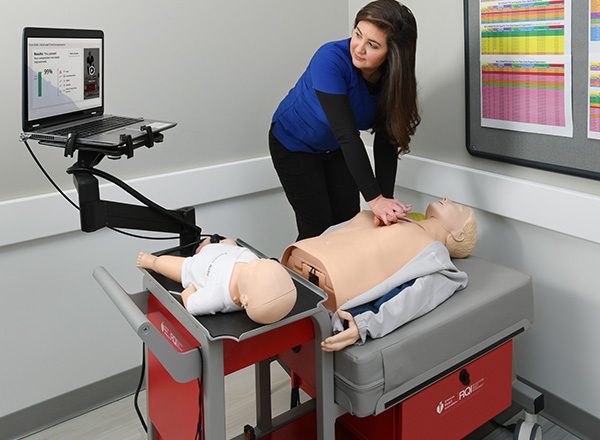Every year, 292,000 adult patients experience in-hospital cardiac arrest. To prepare for such events, every health care provider must complete biennial CPR training. However, survival rates for patients who receive CPR in the hospital are low; one study estimates the survival rate is only around 25%.
CPR training frequency is an important factor contributing to survival rates. The conventional two-year training model results in CPR skills degradation, ultimately barring positive outcomes and lowering survival rates. More frequent training can help providers retain their skills and improve CPR quality, leading to better patient outcomes and greater survival rates for in-hospital cardiac arrests.
How high-quality CPR improves survival rates
The success or failure of CPR depends on several factors related to the circumstances of cardiac arrest. These may include whether the event happened in or out of the hospital, whether the event was witnessed or unwitnessed, and other patient-specific details. The most important factor is the quality of the CPR itself.
In 2010, the American Heart Association (AHA) released updated CPR guidelines, focusing on high-quality CPR as a primary intervention and cornerstone of care that optimizes outcomes even beyond the return of spontaneous circulation. The most common error in CPR involves poor-quality chest compressions — the most basic component of CPR.
Unfortunately, the current model of CPR training leads to skills decay. Some health care providers may only refresh their skills once every two years because the certifications for basic, advanced and pediatric advanced life support are valid for two years.
Even when immediate proficiency in CPR is high, it declines over time. Studies suggest skills degrade occurs within three to six months after the initial training. Many health care providers aren't presented with regular opportunities to practice their CPR skills, which reduces the life-saving measure's potential effectiveness. "High-quality CPR is the 'single greatest determinate for survival' from cardiac arrest and is the foundation for which all other therapies should be built," according to an AHA 2013 Consensus Statement.
5 components of high-quality CPR
Unlike the conventional two-year training model, which only focuses on chest compressions and rescue breathing, high-quality CPR has five core components:
- Chest compression fraction of greater than 80%
- Chest compression rate of 100-120 per minute
- Chest compression depth of 2 inches to 2.4 inches in adults and at least 1/3 the SP dimension of the chest in infants and children
- Allowance for full chest recoil of the compressed chest
- Ventilation of 400-700 cc at fewer than 12 breaths per minute
Proper hand placement is also key. With adult patients, the health care provider's hands should only be placed on the lower half of the sternum.
Mastery of CPR learning with low-dose, high-frequency education
In many cases, health care providers interrupt their regular work schedules to attend in-person CPR training sessions only when they need to renew their certification. Health care systems recently have begun to couple self-directed learning modules with hands-on skills practice to ensure providers can adequately perform CPR. While this gives providers more flexibility to complete their training, it doesn't prevent CPR skills decay over time.
With awareness of this problem, the AHA partnered with Laerdal Medical to develop the Resuscitation Quality Improvement® (RQI®) Program, an initiative for improving CPR mastery learning and increasing patient survival rates. One key element of the RQI Program is increased CPR mastery of skills through regular, measured practice and continual verification of competence. Instead of a lengthy session once every two years, the RQI Program encourages quarterly sessions completed on the student's own schedule - through a low-dose, high-frequency education approach. For many, education can be completed in as little as 10 minutes, although RQI sessions average 30 to 45 minutes.
The RQI Program has three core training components: developing cognitive skills, developing psychomotor skills, and simulating patient cases:
- The RQI Program uses interactive lectures, videos and web-based content to build a solid foundation for CPR skills retention. Providers can use a mobile simulation station offering 24/7 access to learning modules.
- The simulation station also provides an opportunity for students to physically practice high-quality CPR and receive real-time feedback on their performance metrics. This visualization lets providers realize immediately how their CPR delivery affects a patient's chance for survival.
- Simulated patient cases. Students can exercise their skills in simulated patient cases to see how performance improvements could be applied in practice.
Many hospitals have multiple stations throughout the facility, providing easy access to the learning modules and both adult and infant CPR manikins. Dedicated laptop monitors measure all performance metrics while the station is in use, providing both aural and visual feedback to students. The RQI program provides health care providers with a True Adaptive™ learning experience, powered by technology from Area9 Lyceum. The globally-leading Area9 Rhapsode™ learning and publishing platform uses artificial intelligence to deliver a customized, personalized and efficient approach that is driven by an individual's specific knowledge level and unique needs. Employing a vast range of variables and an advanced algorithm, Area9's platform measures time-to-completion, confidence and self-awareness to more accurately assess and respond to each student's individual competence and performance.
The RQI Program Prep courses are full certification courses and will be assigned to participants who are receiving certification for the first time. Entry RQI courses are available as review courses for participants who are already certified. Each time a participant successfully completes the quarterly RQI requirement, the card validation date gets extended by three months. The card received from RQI will also indicate a two-year certification. The card can be utilized for external organizations, but the RQI Program will still need to be completed quarterly for the certification to remain current.
Creating measurable improvement with RQI
The RQI Program dramatically improves CPR performance and skills retention. Health care providers that have implemented this model reflect a marked increase in rates of high-quality CPR practice and competence. The low-dose, high-frequency education model occurs on a quarterly basis with providers reporting greater confidence and an improvement in CPR skills that cannot be matched using conventional resuscitation training techniques, thus making RQI the new standard of care.









